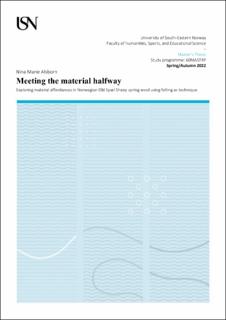| dc.description.abstract | Sustainability and resource usage are presented to us in phrases and terms that we hear about almost every day. In Norway, wool can almost be said to be part of our cultural identity. Despite this cultural importance, a lot of the wool from old and historical sheep breeds are not made use of. One way to honour this wool is to engage with it during felting, a craft that can get one as close to nature as possible when working and creating with wool. Felt requires few resources or processing, and is easily degradable and recycled, in other words, environmentally friendly. Felting wool is therefore sustainable, in the modern sense where environment and natural resources are focused. In this research, I have chosen to work with a method that involves practice as research and emphasises an understanding of new knowledge creation that happens during the practical work, and not only by analysing the samples afterwards – the PaR method. The practice and its outcome are placed within a framework of new materialism as a philosophical lens and affordance as theory, in addition to the historical context of sheep, wool and felt.
By making use of spring wool from Norwegian spæl sheep, we can realise a potential from the past. Our Nordic history shows highly appreciated products made from double-coated, pigmented wool like the one Norwegian Old Spæl Sheep has today. The results show that a potential from the Nordic past can be realised when using tog and/or thel into products that have their features based on the natural properties of the wool. To maximise the potential, I suggest both types of fibres should be used in the future, and that it is key not to lose contact with the natural ecological value of the wool. My results state that spring wool felts fast and well, and the wet felted textiles show a great variety of future usage The coarser tog has proven to play an important role in durability aspects, but so has the way the wool is prepared before felting. For future developments, collaboration between interdisciplinary fields is recommended to enhance finding material possibilities. Findings also stress engineering innovation, to create small scale felting machines to build new industries upon. | en_US |






